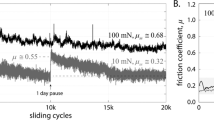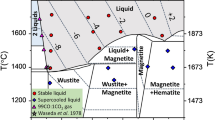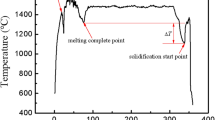Abstract
THE surface tension of liquid metals can be readily measured by the drop-weight method, but Kelly has reported an unexpectedly wide scatter of values when he used this method1. He attributed the variation to the presence of internal voids in the drops which would alter either the contour of the drop, thus affecting measurements based on this parameter, or the presumed density of the drop used to evaluate its volume. Kelly believed that such voids could maintain themselves for an appreciable time in molten drops, and later accepted the cause to be gas present in his material. With electron bombardment devices as used by Kelly, the electron beam may impart angular momentum to the drop as a result of its being incorrectly aligned with respect to the drop surface. Thus the drops can spin about the interface between the metal drop and the rod, creating forces which, combined with the presence of dissolved gas, could lead to a stabilized void. Measurement of the rotation speed of a uniform liquid drop is virtually impossible, and thus comparison of the forces developed with the fracture stress of liquid iron has not been carried out, although Kelly confirmed in a personal communication that rotation was observed and was certainly present in the inductively heated drops in the present work to be described.
This is a preview of subscription content, access via your institution
Access options
Subscribe to this journal
Receive 51 print issues and online access
$199.00 per year
only $3.90 per issue
Buy this article
- Purchase on Springer Link
- Instant access to full article PDF
Prices may be subject to local taxes which are calculated during checkout
Similar content being viewed by others
References
Kelly, J. C., J. App. Phys., 32, 1797 (1961).
Desforges, C. D., thesis, Univ. Cambridge (1964).
Desforges, C. D., and Charles, J. A., in The Electron Microprobe (edit. by McKinley et al.), 562 (Wiley, 1966).
Mendenhall, C. F., and Ingersoll, L. R., Phil. Mag., 15, 205 (1908).
Turnbull, D., and Cech, R. E., J. App. Phys., 21, 804 (1950).
Campbell, J., Trans. A.I.M.E., 239, 138 (1967).
Cline, H., and Ferriss, D. P., Trans. A.I.M.E., 224, 633 (1962).
Author information
Authors and Affiliations
Rights and permissions
About this article
Cite this article
DESFORGES, C., CHARLES, J. Voids in Solidified Iron Alloy Drops. Nature 215, 387–388 (1967). https://doi.org/10.1038/215387a0
Received:
Revised:
Issue Date:
DOI: https://doi.org/10.1038/215387a0
Comments
By submitting a comment you agree to abide by our Terms and Community Guidelines. If you find something abusive or that does not comply with our terms or guidelines please flag it as inappropriate.



